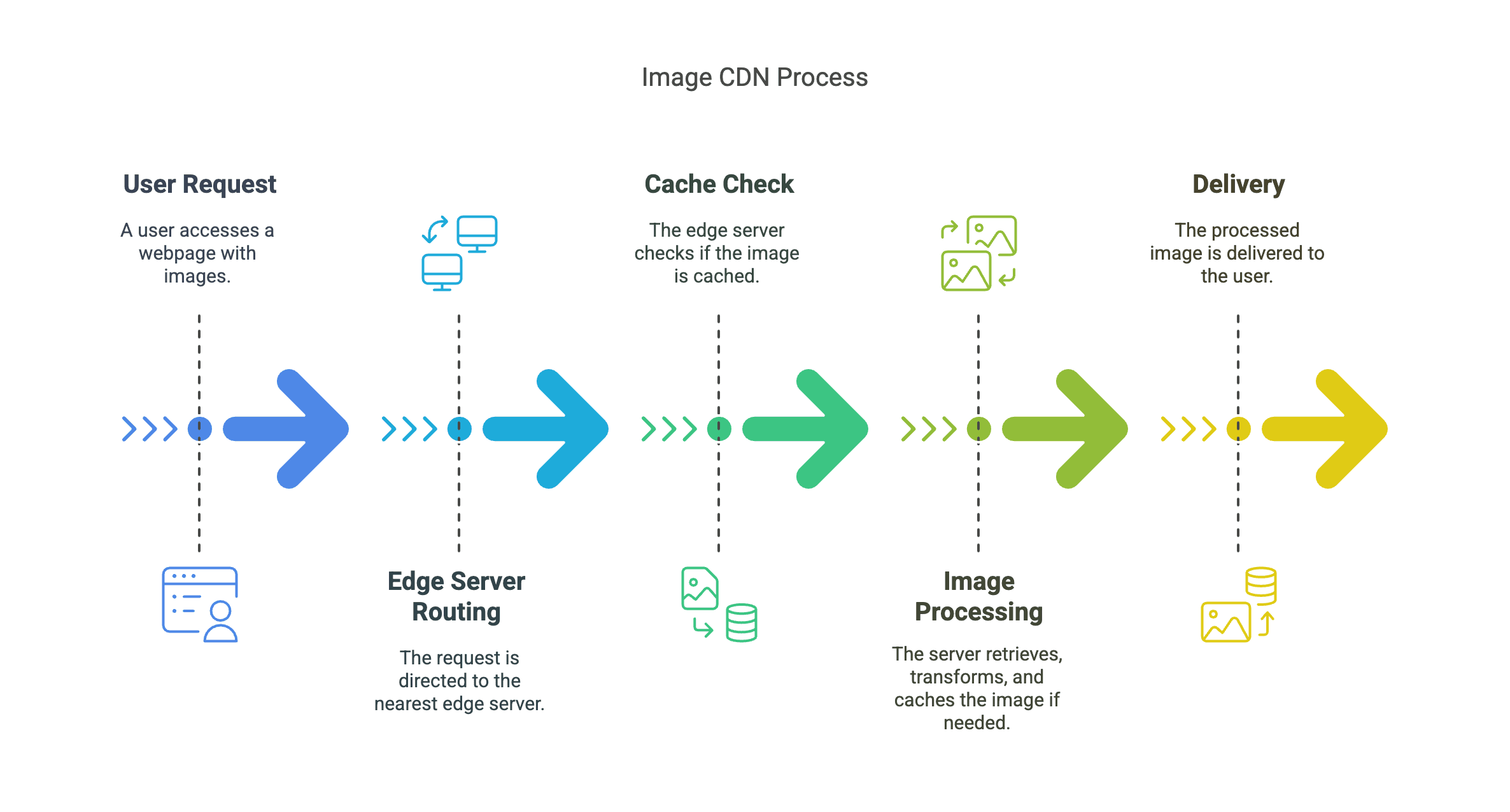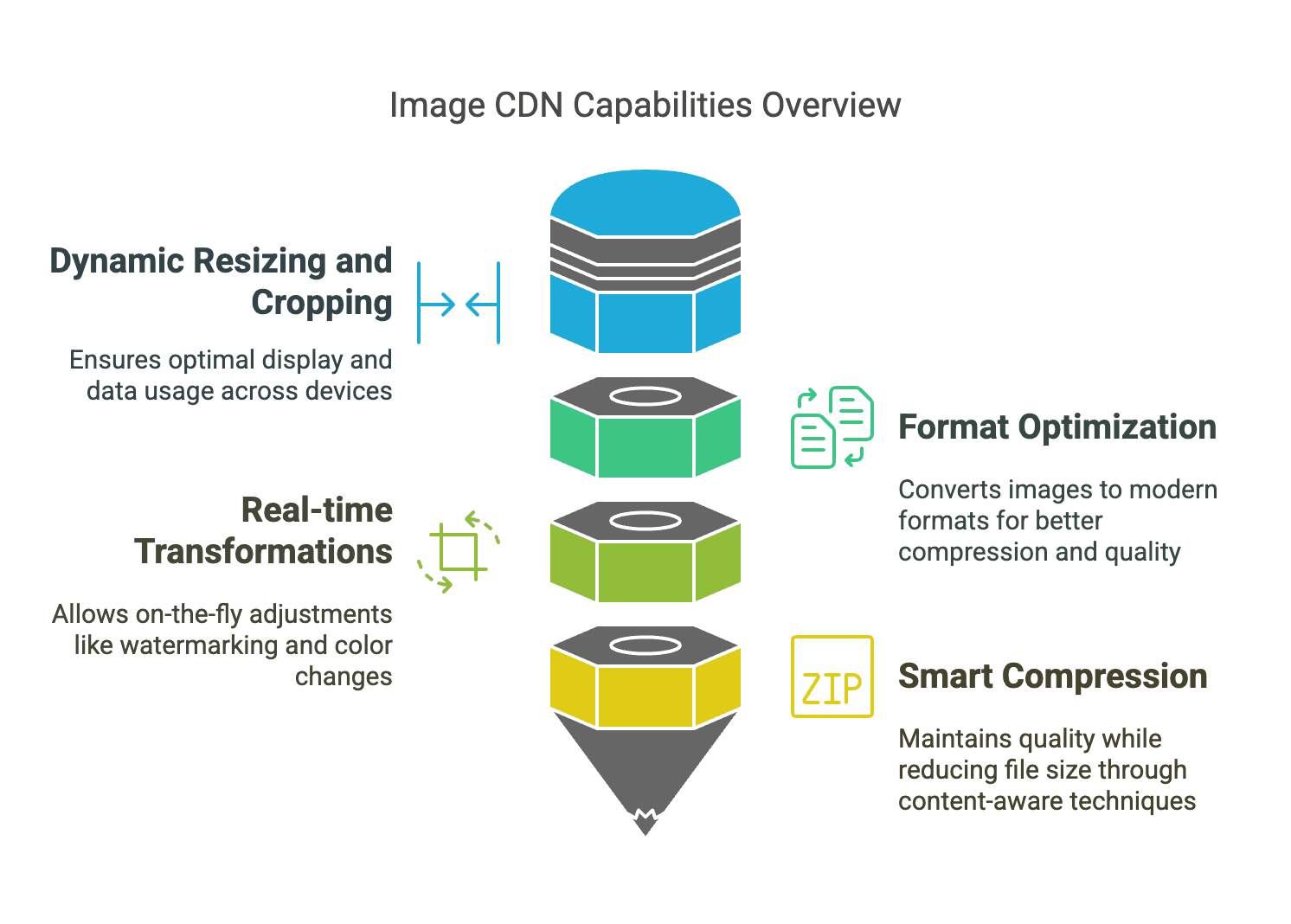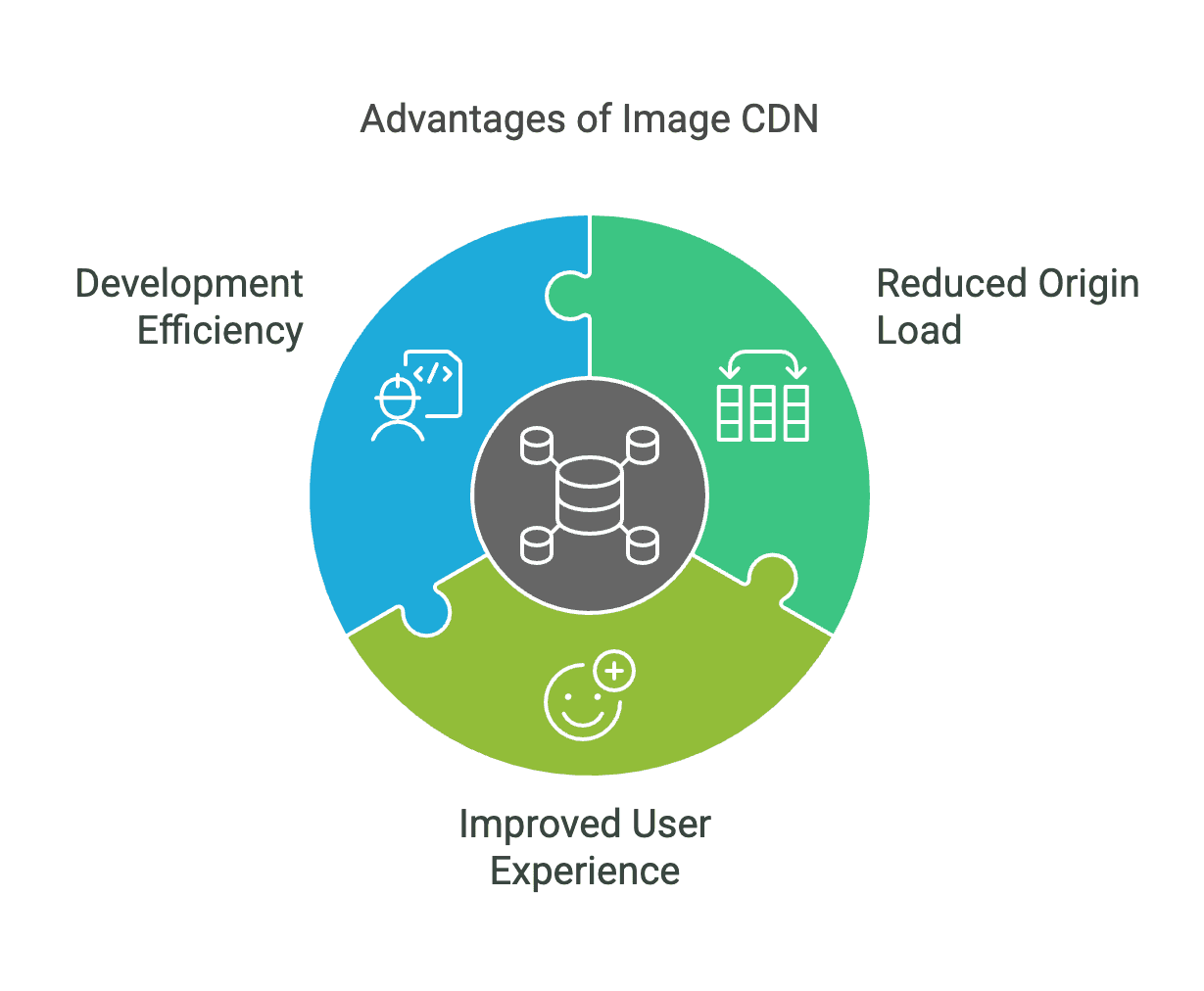Images are an essential part of modern websites, driving engagement and improving conversion rates. However, managing and delivering images efficiently presents significant challenges, particularly in terms of performance optimization and dynamic image processing. An Image CDN (Content Delivery Network) is a specialized cloud service that addresses these challenges through both content delivery and intelligent image processing capabilities.
Understanding Image CDN
An Image CDN combines traditional CDN functionality with advanced image processing capabilities. While it maintains the core CDN feature of distributing content through globally dispersed edge servers, its distinguishing characteristic is the ability to perform real-time image transformations at the edge.
1. Global Edge Network
Image CDNs leverage a global network of edge servers to enhance content delivery speed and efficiency.
- Distributed servers: A network of servers located in various geographical locations allows users to access content from a nearby server, significantly reducing image load times.
- Reduced latency: Serving images from the nearest edge server minimizes latency, leading to quicker load times and a better user experience.
- Efficient caching: Edge servers cache frequently requested images, enabling subsequent requests for the same image to be served directly from the cache, further speeding up delivery.
2. Edge Image Processing Engine
The Edge Image Processing Engine enables real-time modifications to images, allowing for dynamic adjustments based on user needs. This capability eliminates the need for multiple image versions and ensures that users receive optimized images tailored to their devices.
- Real-time transformations: Edge servers modify images on the fly based on user requests, allowing for dynamic changes without storing multiple versions.
- Format conversion: Images are automatically converted to efficient formats (like WebP or AVIF) that reduce file size while maintaining quality, and optimizing loading times.
- Dynamic resizing: Images are resized to fit specific dimensions required by different devices, ensuring optimal image quality for each screen size.
How Image CDNs Work
An Image CDN operates by leveraging a network of edge servers strategically located around the globe. When a user requests an image, the request is routed to the nearest edge server, which can quickly deliver the cached version of the image. If the requested image requires transformation—such as resizing, format conversion, or optimization—the edge server processes the image in real time before delivering it to the user. This minimizes the load on the origin server and reduces latency, ensuring a seamless user experience.
The process typically involves the following steps:
- User Request: A user accesses a webpage that contains images.
- Edge Server Routing: The request is directed to the nearest edge server based on the user's geographical location.
- Cache Check: The edge server checks if the requested image is already cached. If it is, the server delivers it immediately.
- Image Processing: If the image is not cached or requires transformation, the edge server retrieves the original image from the origin server, applies the necessary transformations, and caches the new version for future requests.
- Delivery: The processed image is delivered to the user, ensuring optimal performance and quality.

Advanced Image Processing Capabilities
Image CDNs excel at performing complex image operations at the edge, eliminating the need for pre-processing or maintaining multiple versions of the same image.
The core processing features of an Image CDN provide powerful tools for optimizing images in real time, ensuring that users receive the best possible visual experience while minimizing data usage. These features encompass dynamic resizing, format optimization, real-time transformations, and smart compression.
1. Dynamic Resizing and Cropping
- Automatic sizing: Images are resized to match the user's device resolution, ensuring optimal display without unnecessary data usage.
- Smart cropping: The CDN intelligently crops images to focus on key areas, enhancing visual appeal.
- Responsive generation: Different image versions are created for various screen sizes, ensuring the best experience across devices.
2. Format Optimization
- Modern format conversion: Images are automatically converted to efficient formats like WebP or AVIF for better compression and quality.
- Legacy support: Older browsers receive images in traditional formats, ensuring compatibility.
- Quality-size balance: The CDN adjusts image quality to optimize loading times without sacrificing visual fidelity.
3. Real-time Transformations
- On-the-fly watermarking: Watermarks can be added dynamically for branding without multiple versions.
- Color adjustments: Images can be modified with filters or color changes in real time for consistency.
- Background removal: Backgrounds can be removed on the fly, useful for e-commerce product images.
- Image composition: Multiple images can be combined dynamically for creative layouts.
4. Smart Compression
- Content-aware compression: The CDN analyzes images to apply compression that maintains quality while reducing file size.
- Perceptual quality maintenance: Compression algorithms prioritize visual quality, ensuring appealing images post-compression.
- Metadata optimization: Unnecessary metadata is stripped from images to reduce file size without affecting visual content.
Image CDNs typically use URL parameters to control image transformations, allowing developers to easily specify how images should be processed. For example:
https://cdn.example.com/image.jpg?width=800&format=webp&quality=80
In this example, the URL indicates that the image should be resized to a width of 800 pixels, converted to the WebP format, and compressed to a quality level of 80.

Key Benefits of Image CDN
Image CDN offers significant advantages by reducing the load on origin servers, enhancing user experience, and improving development efficiency. These benefits lead to faster content delivery, optimized resource usage, and a more streamlined workflow for developers.
1. Reduced Origin Load
- Edge processing: Image transformations are handled at edge servers, relieving the origin server of processing requests.
- Cached transformations: Once processed and cached, subsequent requests for the same image are served quickly without additional processing.
- Minimized bandwidth: Fewer requests to the origin server reduce bandwidth usage, leading to cost savings and improved performance.
2. Improved User Experience
- Faster loading: Images served from the nearest edge server significantly improve loading times.
- Device optimization: Users receive images tailored to their specific devices, enhancing visual quality.
- Reduced data consumption: Optimized images consume less data, which is crucial for mobile users.
3. Development Efficiency
- Single source maintenance: Developers maintain a single version of an image, simplifying management.
- Dynamic adaptation: Images can be adapted on the fly to meet varying requirements, streamlining development.
- Simplified workflow: A centralized system for image processing and delivery makes image management more efficient.

Use Cases For Image CDN
Image CDNs are particularly valuable for:
- E-commerce platforms: E-commerce sites often need different image sizes and formats for various devices and display contexts. An Image CDN can dynamically generate these variants, improving load times and user experience.
- Media sites: News and media websites frequently update their content with images. An Image CDN can handle the high volume of requests and transformations required to keep content fresh and engaging.
- Mobile applications: Mobile apps benefit from optimized images that load quickly and display well on various screen sizes, enhancing user satisfaction.
- Social media platforms: Social media sites often deal with a vast array of user-uploaded images. An Image CDN can efficiently process and deliver these images, ensuring a smooth user experience.
- Global websites: Websites with a global audience need to cater to various devices and connection speeds. An Image CDN can optimize images for different scenarios, ensuring consistent performance across the board.
Optimize Images Using EdgeOne Image CDN
EdgeOne Image CDN offers a comprehensive set of features designed to optimize image delivery and enhance the user experience. By utilizing edge computing, EdgeOne processes images at servers closest to the user, significantly reducing latency and improving loading times. The CDN supports dynamic resizing, which ensures that images are customized to fit the specific dimensions and resolutions of various devices, enhancing visual quality while minimizing data usage.
Furthermore, EdgeOne Image CDN automatically converts images to modern formats like WebP and AVIF. These formats provide superior compression without compromising quality. This combination of format optimization and intelligent compression techniques ensures that images load quickly and efficiently, even on mobile networks.
In summary, EdgeOne Image CDN streamlines image management for developers and delivers a faster, more engaging experience for users, making it an essential tool for any digital platform.
Conclusion
Modern Image CDNs go far beyond simple content delivery, offering sophisticated edge processing capabilities that transform how images are managed and delivered on the web. Their ability to perform real-time transformations while maintaining high performance makes them an essential tool for modern web development. By leveraging the power of an Image CDN, businesses can enhance user experience, reduce operational costs, and streamline their image management processes.
EdgeOne is not just an Image CDN; it's a one-stop acceleration and security solution. We invite you to experience EdgeOne—sign up now for a free trial!

